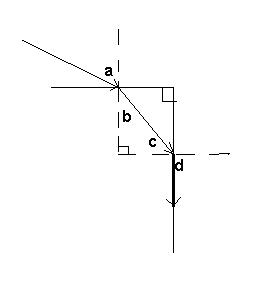Eiba
Warlord
I've lurked here for a while, and noted that there seem to be a good number of people who are good at math/science.
Well in my physics class today we were doing some practice problems having to do with light refraction/reflection, prisms, etc. though as it turned out there was one question that my teacher couldn't even figure out. I think I got an answer, but it's really convoluted- my teacher was unable to verify if it was right or wrong, and so I ask the forumgoers of CFC: How do you do this problem?
"A given monochromatic light ray, initially in air, strikes the 90 degree prism at P and is refracted there and at Q to such an extent that it just grazes the right-hand prism surface after it emerges into air at Q."

(I apologize for my poor Paint skills... hopefully you get the picture)
"Determine the index of refraction, relative to air, of the prism for this wavelength in terms of the angle of incidence (theta-sub-1), which gives rise to this situation. n = _____"
My teacher said we could assume "just grazes the surface" to mean that it's 90 degrees from the normal. Using Snell's law and some trigonometry I got two equations (writing theta-sub-1 as theta1 for simplicity) where theta-sub-2 (theta2) is the angle between the normal and the light ray at point P:
1 * sin theta1 = n * sin theta2
n * (sin 90 - theta2) = sin 90 * 1 = 1
Or (because of the way the triangle works):
n * cos theta2 = 1
I solved the second equation for n and got (1 / cos theta2) then plugged that into the first equation for:
sin theta1 = sin theta2 / cos theta2 = tan theta2
I thought that was a dead end, so mainly to fool around I tried solving for theta2:
arctan sin theta1 = theta2
Then plugging that into the first equation:
sin theta1 = n * sin arctan sin theta 1
or:
n = sin theta1/sin arctan sin theta1
And that is technically n in terms of theta1... But it's a horribly ugly answer... My physics teacher said I had a twisted mind to come up with such a thing.
Can anyone tell me where I went wrong or how to do it? Or if that's actually right?
I'll be happy to clarify if anything I wrote is unclear.
Well in my physics class today we were doing some practice problems having to do with light refraction/reflection, prisms, etc. though as it turned out there was one question that my teacher couldn't even figure out. I think I got an answer, but it's really convoluted- my teacher was unable to verify if it was right or wrong, and so I ask the forumgoers of CFC: How do you do this problem?
"A given monochromatic light ray, initially in air, strikes the 90 degree prism at P and is refracted there and at Q to such an extent that it just grazes the right-hand prism surface after it emerges into air at Q."

(I apologize for my poor Paint skills... hopefully you get the picture)
"Determine the index of refraction, relative to air, of the prism for this wavelength in terms of the angle of incidence (theta-sub-1), which gives rise to this situation. n = _____"
My teacher said we could assume "just grazes the surface" to mean that it's 90 degrees from the normal. Using Snell's law and some trigonometry I got two equations (writing theta-sub-1 as theta1 for simplicity) where theta-sub-2 (theta2) is the angle between the normal and the light ray at point P:
1 * sin theta1 = n * sin theta2
n * (sin 90 - theta2) = sin 90 * 1 = 1
Or (because of the way the triangle works):
n * cos theta2 = 1
I solved the second equation for n and got (1 / cos theta2) then plugged that into the first equation for:
sin theta1 = sin theta2 / cos theta2 = tan theta2
I thought that was a dead end, so mainly to fool around I tried solving for theta2:
arctan sin theta1 = theta2
Then plugging that into the first equation:
sin theta1 = n * sin arctan sin theta 1
or:
n = sin theta1/sin arctan sin theta1
And that is technically n in terms of theta1... But it's a horribly ugly answer... My physics teacher said I had a twisted mind to come up with such a thing.
Can anyone tell me where I went wrong or how to do it? Or if that's actually right?
I'll be happy to clarify if anything I wrote is unclear.





